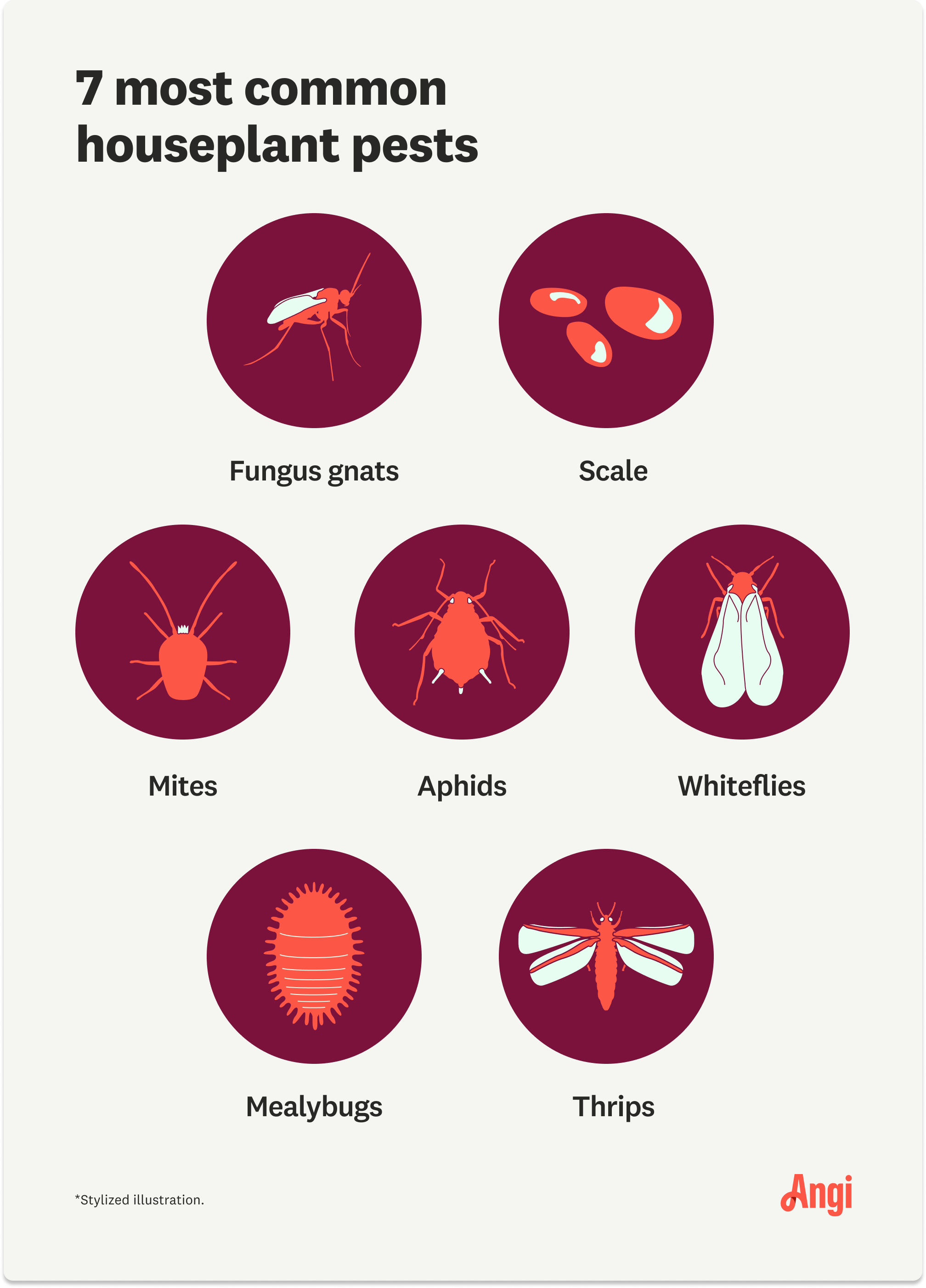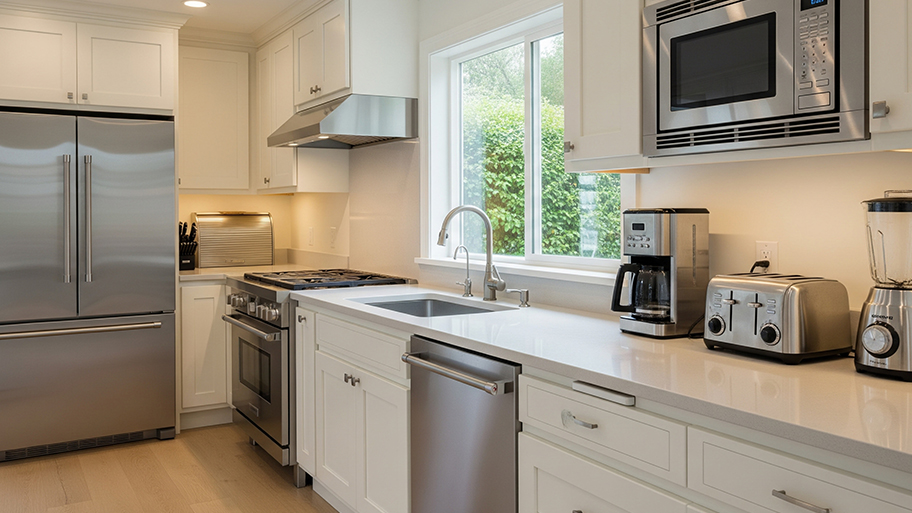
Keep your home free of termites and the damage they do. Learn more about inspections, infestations, and the average cost of termite treatments.
These remedies will leave them dropping like flies


Stressed plants are prone to pest infestations.
Regular watering and keeping humidity levels up will help prevent pests from attacking your houseplants.
Common houseplant pests include aphids, mealybugs, scale, and mites.
Use neem oil and insecticidal soap to treat most houseplant pests.
Your houseplant obsession may be taking over your home, but that doesn't mean plant pests have to. The good news is indoor plant infestations are far less common than outdoor garden pests— and they’re relatively easy to treat with natural pest control solutions. Here are the most common houseplant pests and how to treat them.


Fungus gnats are among the most common indoor plant pests, primarily because they're caused by overwatering. Moisture-loving fungus gnats lay their larvae in damp soil and can cause some root damage to your houseplants.
You can prevent fungus gnats by allowing the soil to dry out completely between waterings and ensuring your pots have adequate drainage. Once the soil has dried, the gnats will often die. If this doesn’t seem to cut it, you can try a few other tricks.
Lay small sticky traps on the edge of the pots near the soil, being careful not to let the traps touch your leaves.
Use a natural insecticide called Bacillus thuringiensis, a naturally occurring bacterium. However, use caution and keep your pets and children away when applying. Follow the manufacturer's instructions for application when using a spray, and wear gloves and spray outside or in a well-ventilated area.
If you notice yellow spots on your plant's leaves and leaf drop, look closely at the stem and undersides of the leaves. Your plant probably has scale if you see a clear sticky substance and small brown or white dots. They’re sapsuckers and either soft-bodied or hard-bodied (armored). Soft-bodied scale, as well as immature scale, are more susceptible to insecticides.
Scale can spread pretty quickly to other plants, and the sticky substance can attract ants. Follow these steps to get rid of them.
Wipe the scale off the plant. You can remove stubborn, harder scale on the stems with your fingernail or a dry toothbrush.
Rinse the plant with water to remove any scraped-off scale.
Treat the plant with either insecticidal soap or neem oil since there may still be larvae on the leaves.
Allow the plant to dry completely.
Repeat this treatment every week until the infestation is gone.
Spider mites are tiny, but one of the telltale signs of a houseplant infestation is webbing on the undersides of leaves. Mites suck the juice right out of leaves, leaving them pale, stippled, and dried out.
Because they’re such small insects, put a piece of white paper under the leaves and tap to see if you have spider mites. If something that looks like pepper appears on the paper, it’s probably them.
First and foremost, ensure your plants are getting watered regularly since chronically dry plants tend to attract mites. In addition, regular misting and humidity are a natural antidote to mites. Follow these steps to get rid of them.
Wash the leaves if the infestation is mild.
Wipe the leaves down to remove any mites, and then spray the undersides and tops of the leaves with insecticidal soap or neem oil. Follow the manufacturer’s instructions for application.
Treat the plant again once a week until the mites are gone.
Like scale, aphids can leave behind a sticky substance on leaves. You may notice your houseplant’s leaves are looking wilted or discolored. Look closely for pinhead-sized insects that may be black, pink, white, or even pale green. The good news is you can DIY aphid removal with nontoxic solutions and without harming your plants.
Aphids are common in your outdoor garden, but they can also infest houseplants. Plants that have been overfertilized are more susceptible to infestations. The good news is you can treat your plant with nontoxic solutions. Follow these steps to get rid of aphids.
Rinse plants off with a strong stream of water, such as from a sink sprayer or showerhead.
Keep the plant isolated, and inspect it the next day for aphids.
Create a solution of 1 ½ teaspoons of dish soap and 1 quart of water for stronger infestations. Mix this in a larger container, and then pour it into a household spray bottle to ensure you’re getting the correct ratio.
Spray the leaves where insects appear, and cover the top and bottom of the leaf.
Repeat the process every four to seven days until you see improvement.
Use neem oil or a commercial insecticidal soap spray if the above method isn’t effective.
As the name suggests, adult whiteflies are white and can appear on the top and undersides of leaves, sucking their juice. The plant leaves can curl up, turn brown or yellow, and look dry.
Whiteflies generally require at least one neem oil treatment or insecticidal soap to eliminate them effectively. Follow these steps to get rid of them.
Rinse the leaves or wipe with a wet cloth.
Mix the neem oil or insecticidal soap according to the directions.
Spray the tops and undersides of every leaf, even leaves that may not appear to have whiteflies on them.
Keep the plant away from other plants for several days, and inspect for further infestations.
Repeat the above steps once a week until the insects are gone.
Mealybugs are sapsuckers that, like aphids and scale insects, leave behind a clear sticky substance on the leaves. They have a fuzzy white appearance.
They’re relatively common houseplant pests you can usually spot when your plant leaves start turning yellow. Approach mealybug control in a similar way to scale infestation. Follow these steps to get rid of them.
Wipe the bugs off of the plant with a paper towel or cotton swab soaked in a little bit of rubbing alcohol.
Rinse your plant.
Keep your plant separate from others for a few days.
Treat with neem oil or insecticidal soap after rinsing the plant if the infestation is heavier.
Repeat once a week until the infestation is under control.

Thrips are small dark brown bugs with wings. Although less common than some other indoor houseplant pests, thrips can quickly destroy a plant. Signs of a thrip infestation include leaves streaked with white or silver, which look depleted and then fall off.
Plants that are too dry and don’t get enough humidity are prone to thrip infestation. Treatment almost always involves insecticidal soap or neem oil. Follow these steps to get rid of them.
Remove as many thrips as possible with a damp cloth or cotton swab, and rinse with water if the infestation is mild.
Spray the entire plant, including the top and undersides of leaves and the stem, and allow it to dry.
Keep the plant isolated and check for further infestation.
Repeat the treatment as needed.
Treat some thrip infestations with a pyrethrin-based spray if insecticidal soap or neem oil doesn't work.
Use a systemic houseplant insecticidal treatment to control thrip reinfestation.
When treating plants for bugs, there are important steps to keep you, your family, and your plants safe.
Isolate an infested plant as soon as you notice any signs of pests, and keep your plant in quarantine during treatment.
Both neem oil and nontoxic insecticidal soaps come in ready-to-spray and concentrated forms. Make sure you know which kind you have so you don’t damage your plants. And follow the manufacturer’s instructions carefully for mixing. (Hint: These solutions also help treat powdery mildew.)
Never treat plants with any kind of pesticide in direct sunlight, as it can burn the leaves.
Make sure plants have been adequately watered before any treatment.
Wear gloves when applying even nontoxic treatments, and treat in a well-ventilated area or outdoors if possible.
Keep all pesticides and fertilizers away from pets and children.
Use systemic houseplant treatments to treat a variety of insects. These are sprinkled in and mixed lightly onto the top of the soil and break down as you water.
Inspect plants before you buy them to look for any signs of infestation.
If your houseplants seem to attract more bugs than you can control, consider hiring a local gardener to evaluate your light and humidity conditions and suggest a better location for your houseplants.
There are common problems leading to pest infestations in any home. The best way to prevent houseplant pest infestations is to keep your houseplants healthy by ensuring adequate light, water, and humidity. Stressed plants effectively send out beacons to bugs that they’re too weak to defend themselves.
Keep these tips in mind to keep your plants healthy:
Not all plants require the same light conditions. While many indoor plants prefer bright, indirect light, some can tolerate lower light, and others even prefer diffused sunlight.
Humidity is every indoor plant’s friend. Run a humidifier in rooms where you have many plants, especially during the winter when indoor air tends to be drier.
Add essential oils to a humidifier to repel pests (and make your house smell amazing).
Alternatively, you can mist your indoor plants with a sprayer. Try to mist every other day.
Increase the humidity by placing plants on a tray of pebbles with water.
Feed your houseplants a diluted solution of plant food every other watering during the active growing season (spring and summer), typically every two weeks. Reduce this to every fourth watering in the fall and winter, approximately once a month.
From average costs to expert advice, get all the answers you need to get your job done.

Keep your home free of termites and the damage they do. Learn more about inspections, infestations, and the average cost of termite treatments.

Whether you have bugs, bats, or rodents invading your home, you’ll want to contact an exterminator quickly. Find out how much pest control costs in Columbus, OH.

How much does bee removal cost? Learn what you’ll pay based on factors like hive location, size of the infestation, extermination or removal, and more.

Foxes are opportunistic scavengers, so you don’t want to give them an excuse to park on your property. Learn how to keep foxes away from your yard.

Cockroaches are drawn to the warmth and darkness provided by appliances. To prevent an infestation, learn how to get roaches out of appliances for good.

If you see a mouse hole in the wall, it’s time to seal your house from mice. Our guide will show you how to safely and humanely seal a house from mice.